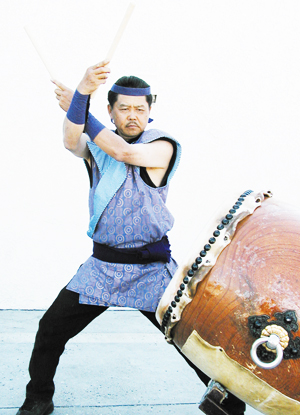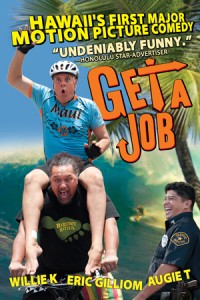Archive / Taiko Master : Etsuo Hongo
Cultural News 2005 April Issue

Cultural News 2005 April Issue / Tokyo native Etsuo Hongo of Los Angeles, 54, is teaching taiko in Los Angeles area for three decades. He is one of the pioneers who have developed taiko activities in Southern California. (Cultural News Photo)
Taiko: Primal Beat
By Fumie Iida
Tokyo native Etsuo Hongo of Los Angeles, 54, started teaching taiko in 1977 at a basement of a Buddhist temple in Little Tokyo. Hongo is one of the pioneers who have developed taiko activities in Southern California.
Hongo says that there are more than 250 taiko groups in the United States and Canada, of which there are more than 40 taiko groups between Fresno and San Diego.
In the 1970s, those groups were originally based at Buddhist temples and had developed along with the Buddhist temples’ ceremonies and community festivals. Once taiko became increasingly popular, more individuals, even those not of Japanese heritage, started to form taiko groups to enjoy taiko as music.
“Taiko is a type of music that is easily understandable to people everywhere. Taiko is sort of primal; a feeling comes straight to your heart,” says Mike Jaffe of Japan Foundation Los Angeles. Jaffe is taking Hongo’s lessons at a class in Little Tokyo.
Hongo was born in Shinbashi, and brought up in Azabu, the historical center of Tokyo. He was brought up by listening and watching taiko performances in the old town of Japan’s capital.
“In the summer time, I used to go to every bon-dance that took place all over Tokyo by riding a bicycle,” Hongo says. He had already begun to play taiko in the center of bon-dance circles as early as the age of 11.
“I was attracted by the Oedo Sukeroku Taiko’s performance that expresses ‘iki,’ the idea of Edo stylishness,” Hongo says, “They hit taiko with acrobatic actions; they jumped, performed somersaults and threw bachi sticks in the air. I learned the performance that was enjoyable to listen and to watch.”
He wanted to see how Oedo Sukeroku Taiko, the group he admired, was doing here in the United States after it had established a branch in San Francisco in 1967.
Even after three decades of tireless efforts, his passion for introducing authentic taiko is still burning strong. Currently, Hongo is teaching taiko at four locations: “Taiko Okita-gumi” at Nishi Hongwanji Temple in Little Tokyo, “Mugen Taiko” at San Fernando Valley Japanese American Community Center, “Koshin Taiko” at Venice Japanese American Community Center, and children’s classes at El Marino Elementary School, a magnet school in Culver City.
Although Hongo does not teach acrobatic actions very often, his way of teaching taiko is based on the Sukeroku-style which focuses on the standing position, posing and the angle of hitting the taiko with sticks.
“You don’t need much strength to make a good taiko sound. It is important how you hit taiko,” he says.
During a class at Nishi Hongwanji on a Wednesday evening in March, he emphasizes how important the basics are to his pupils. As he walks around in the concrete-walled basement of the temple, Hongo looks at his pupils’ every movement with earnest eyes. Deep and loud taiko sounds shake metal chairs and deeply resonate in the stomach.
“Relax your arms and don’t grab the sticks too hard. Focus on your position and your body movement,” Hongo tells them vociferously as they hit the taikos.
“Taiko is music. But it’s part performance and part – even almost like – martial art. You have to focus on concentrating in your energy,” Jaffe says, “It’s music, but it’s more than music.”
“Hongo sensei’s teaching is a more traditional Japanese style and authentic to me. It’s unique and interesting,” Jason Fukuman and another Hongo’s students, says. Fukuman, a 21-year-old from Torrance, has been learning taiko since he was 5 years old. In July 2004, he placed third in a regional competition known as Southern California Taiko Contest.
As a third generation Japanese-American, Fukuman is determined to acquire traditional Japanese taiko skills. “I’m hoping to go to Japan to study with Oedo Sukeroku Taiko group someday,” he says. Hongo says that there are a lot of Japanese-American who are interested in taiko. “I think they can establish their ethnic identity by taiko,” he says.
Besides teaching more than 30 years, he has invited various types of taiko groups from Japan to introduce authentic taiko performances to American players and audiences. Hongo says it is a good trend that a lot of people are interested in taiko; however, he thinks it is time for him to make some effort to improve the skill levels of players as a whole. “I want people to know what true taiko is,” Hongo says.
In pursuit of his new quest, Hongo will host the first “North America Taiko Contest” in Los Angeles on Friday, July 15 to coincide with the fifth nationwide Taiko Conference in Little Tokyo. The venue will be announced shortly.
The judges of the contest will include: Master Seiichi Tanaka of San Francisco Taiko Dojo, Kiyonari Tosha of Nihon Taiko Dojo in Tokyo and former member of Oedo Sukeroku Taiko, and Masakazu Yoshizawa, a professional musician specializing in Western classic and traditional Japanese.
Hongo says, “Competing with each group is not the point of this event. I want every group to be more serious about playing the taiko. I hope this contest will be a good opportunity for everyone to improve his or her skill.”
Fumie Iida is a freelance writer. After graduating from Waseda University, she worked at an advertising agency in Tokyo for five years. She was a staff writer, photographer and assistant sports editor of the El Camino College newspaper Union. She came to the United States in 2002 to study American journalism and public relations.
(C) Cultural News, Inc.

